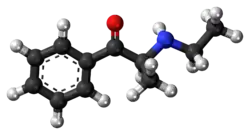 | |
 | |
| Clinical data | |
|---|---|
| Other names | N-Ethylcathinone; 2-Ethylaminopropiophenone |
| Routes of administration | By mouth, intranasal |
| ATC code |
|
| Legal status | |
| Legal status | |
| Identifiers | |
| |
| CAS Number |
|
| PubChem CID | |
| IUPHAR/BPS | |
| ChemSpider | |
| UNII |
|
| KEGG | |
| CompTox Dashboard (EPA) | |
| Chemical and physical data | |
| Formula | C11H15NO |
| Molar mass | 177.247 g·mol−1 |
| 3D model (JSmol) | |
| Chirality | Racemic mixture |
| Melting point | 195 to 198 °C (383 to 388 °F) (hydrochloride) |
| Boiling point | 272.3 °C (522.1 °F) at 760 mmHg (hydrochloride) |
| |
| |
| (verify) | |
Ethcathinone, also known as ethylpropion or ETH-CAT, is a stimulant drug of the phenethylamine, amphetamine, and cathinone chemical classes. It is an active metabolite of the prodrug diethylcathinone and is fully responsible for its effects. Ethcathinone has been identified as an ingredient in both quasi-legal "party pills",[3] and, along with mephedrone, has also been reported as having been sold as "ecstasy" in the Australian city of Cairns.[4][5]
Pharmacology
The pharmacology for ethcathinone appeared alongside other psychostimulants in a paper by Rothman and Baumann in 2006.[6] The predominant two modes of action for ethcathinone is as a moderately active releaser of noradrenaline (EC50 = 99.3 nM);[6] however it is only a relatively weak inhibitor of dopamine reuptake (Ki = 1,014 nM).[6]
Since diethylcathinone appears to be an inactive prodrug and only becomes active after it has been further metabolized to ethcathinone,[6] it thereby would appear rational to consider that ethcathinone would also be expected to be N-dealkylated upon its consumption to the more active drug cathinone that is more able to reliably stimulate the release of dopamine. However, in contrast to diethylcathinone, ethcathinone is not universally considered to be a prodrug since (as is the case with tramadol, codeine, and MDMA) it is already active in its own right, therefore being excluded from the category by some of the more strict definitions.
Legal status
Ethcathinone, along with mephedrone and flephedrone, was banned in Denmark on December 18, 2008.
As of October 2015 Ethcathinone is a controlled substance in China.[7]
This compound is banned in the United States, being a positional isomer of mephedrone.[8]
See also
References
- ↑ Anvisa (2023-07-24). "RDC Nº 804 - Listas de Substâncias Entorpecentes, Psicotrópicas, Precursoras e Outras sob Controle Especial" [Collegiate Board Resolution No. 804 - Lists of Narcotic, Psychotropic, Precursor, and Other Substances under Special Control] (in Brazilian Portuguese). Diário Oficial da União (published 2023-07-25). Archived from the original on 2023-08-27. Retrieved 2023-08-27.
- ↑ DEA Controlled Substances Act listing dated 21-Jul-15
- ↑ Camilleri A, Johnston MR, Brennan M, Davis S, Caldicott DG (April 2010). "Chemical analysis of four capsules containing the controlled substance analogues 4-methylmethcathinone, 2-fluoromethamphetamine, alpha-phthalimidopropiophenone and N-ethylcathinone". Forensic Science International. 197 (1–3): 59–66. doi:10.1016/j.forsciint.2009.12.048. PMID 20074881.
- ↑ Killer pills hit Cairns
- ↑ Police warn of potentially fatal 'fake ecstasy'
- 1 2 3 4 Rothman RB, Baumann MH (2006). "Therapeutic potential of monoamine transporter substrates". Current Topics in Medicinal Chemistry. 6 (17): 1845–59. doi:10.2174/156802606778249766. PMID 17017961.
- ↑ "关于印发《非药用类麻醉药品和精神药品列管办法》的通知" (in Chinese). China Food and Drug Administration. 27 September 2015. Archived from the original on 1 October 2015. Retrieved 1 October 2015.
- ↑ DEA Controlled Substances Act listing dated 21-Jul-15